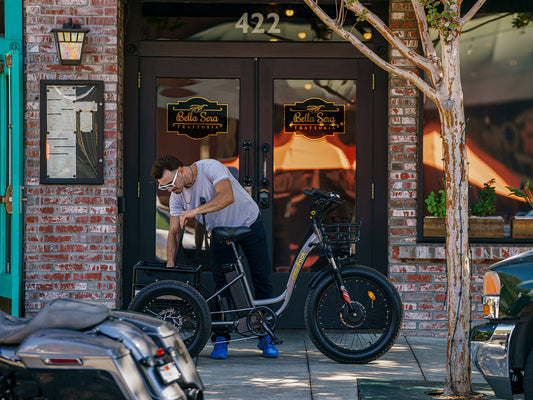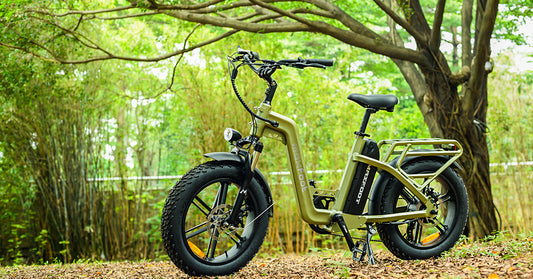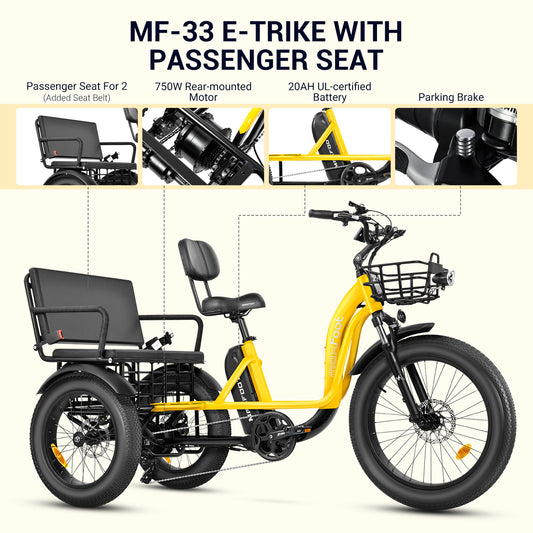It’s tempting to just pay the money and hop on your new electric bike without giving much thought to the technology behind it. After all, you just want to enjoy the ride, right?
See, this is where many people go wrong. If you don’t understand how electric bike motors operate, you risk more than just a bad riding experience. You could be putting unnecessary strain on your bike and compromising your safety. Misusing features like the pedal-assist or throttle or not knowing the differences between hub motors and mid-drive motors can lead to problems like quicker battery drain, overheating, unexpected breakdowns, costly repairs, and increased e-bike maintenance costs.
So, before you hit the road, it’s worth taking a few minutes to understand the e-bike motor that powers your ride.
Let’s get right into it!
First Off, What Is an Electric Bike?
An electric bike is just like a regular bicycle but with a few extra parts that give it a boost. The main difference is the addition of a motor, a battery, and a system to control them. These additional components work together to help you pedal with less effort or even move without pedaling at all.
Pedal-Assist vs. Throttle
There are two main ways an electric bike motor can assist you: pedal-assist and throttle.
Pedal-Assist
This is the most common setup. It gives you a boost when you pedal. The harder you pedal, the more help you get from the motor. This system uses sensor technology to detect your effort and adjust accordingly. It’s great for climbing hills or riding longer distances without getting tired.
Throttle
With a throttle, you can get power from the motor without pedaling at all. You just have to twist a handle or push a button, and the motor engages and propels the bike forward, just like a motorcycle. This is a fun way to ride, especially if you need a break from pedaling or want to speed up quickly from a stop.
Please note that some electric bikes have both pedal-assist and throttle modes, so you get the best of both worlds.
The Key E-bike Components
To understand how electric bike motors work, let’s look at the main e-bike components:
Motor: It’s the heart of the e-bike that converts the energy stored in the battery into mechanical power to help you pedal.
Battery Power: This is the fuel tank of your e-bike. It stores the electricity that runs the motor.
Motor Controller: Think of it as the brain of the e-bike. It manages the amount of power that goes from the battery to the motor.
Sensor Technology: Sensors detect how you’re riding and tell the motor controller how much help to give you.
Types of E-bike Motors
There are different types of motors used in e-bikes. The two main kinds are hub motors and mid-drive motors.
Hub Motors
Hub motors are located in the center (hub) of either the front or rear wheel. They are usually quieter and require less maintenance. They work independently of the bike’s gears, which can be a good thing if you want something simple.
- Front Hub Motors:These are placed in the front wheel. They pull you forward like a front-wheel-drive car. They’re easy to install and are often found on simpler (and less expensive) e-bikes. However, they don’t offer as much traction, especially on slippery surfaces.
- Rear Hub Motors:These are located in the back wheel and are designed to push you forward. They provide better traction, especially when climbing hills or carrying heavy loads.

Mid-Drive Motors
Mid-drive motors are located in the middle of the bike, usually between the pedals. They send power directly to the bike’s chain, working with the gears.
Mid-drive motor e-trikes offer better balance than hub motors because the weight is centered. They also handle hills more efficiently since they use the bike’s gears. That said, they can be more expensive and may require more maintenance because they put extra strain on the bike’s chain and gears.
How Do E-bike Motors Work?
Now that you’ve got an idea of the types of e-bike motors, let’s see how they make the bike move.
Electric Bike Propulsion
The sensor technology kicks in when you start pedaling or use the throttle.
Sensors detect your pedaling speed and force. This information goes to the motor controller, which decides how much power to send from the battery to the motor.
- In pedal-assistmode, the harder you pedal, the more the sensors tell the controller to help you out.
- In throttle mode, the motor provides power based on how much you twist the throttle without pedaling.
Motor efficiency is important here. Efficient motors use less battery power to provide the same amount of help, so you can ride longer on a single charge.
Battery Power and Motor Efficiency
The battery power determines how far and how fast you can go. E-bike batteries are usually lithium-ion, like those in smartphones, but bigger. They can be recharged by plugging into a standard outlet.
Most e-bike batteries take between 3 to 6 hours to fully charge. Those with a higher capacity may take up to 9 or 10 hours. Battery capacity is measured in watt-hours (Wh). Higher numbers mean more energy and longer rides.
Motor power typically ranges from 250W to 750W. More watts mean more power, but they also use more battery power.
The Role of Sensor Technology
Sensors are a key part of how electric bike motors work. They make riding smooth and responsive by continually adjusting the motor’s help to match your needs.
Common types include:
- Torque Sensors:They measure how hard you’re pedaling. More force means more assistance from the motor.
- Cadence Sensors:They detect if you’re pedaling and how fast. They provide consistent assistance as long as you’re turning the pedals.
- Speed Sensors:They keep track of your speed to help regulate motor power and keep you within legal speed limits for e-bikes.
Tips for Motor Maintenance and Care
Regular e-bike maintenance is essential to keep your vehicle running smoothly. Here are a few tips to ensure it stays in top shape:
- Wipe down your e-bike after each ride, especially if you’ve ridden through rain or mud.
- Keep your motor clean and dry.
- Avoid using high-pressure water near the motor and battery, as it could damage sensitive electronic components.
- Pay attention to brake pad wear. E-bikes are heavier and go faster than regular bikes, so brakes wear out quicker.
- Charge your battery properly, following the manufacturer’s guidelines. Avoid letting it drain completely before recharging, as this can reduce lifespan. Try to recharge when the battery reaches 20-30% for the best longevity.
- Store your e-bike in a cool, dry place to protect the motor and battery from weather damage.
- Regularly check the motor housing and wires for any signs of damage. If you notice unusual noises or a decrease in performance, get in touch with a professional for an inspection.
Tips to Improve E-bike Performance
Improving your e-bike performance involves more than just keeping the motor in good condition. Here are some tips to enhance your overall riding experience:
1. Use the Right Assist Mode:
Most e-bikes have multiple pedal-assist levels, such as Eco, Tour, and Sport. Lower modes, like Eco, use less battery power, while higher modes offer more power but drain the battery faster.
Your best bet is to switch between these modes depending on the terrain to conserve battery power and improve efficiency.
2. Optimize Tire Pressure:
Maintaining proper tire pressure can make a big difference in both speed and motor efficiency.
Under-inflated tires increase resistance and make the motor work harder. As a result, the battery drains faster.
3. Keep the Battery Cool:
Overheating can reduce battery life and affect motor performance.
If you’re planning a long ride, avoid exposing the battery to extreme heat. It’s also recommended you let the battery cool down before charging after a strenuous ride.
4. Lubricate Moving Parts:
A well-lubricated chain, gears, and pedals help reduce friction, allowing the motor to operate more efficiently. Friction can slow you down, making the motor work harder to provide assistance.
So, make it a habit to check these moving parts regularly, especially if you have a mid-drive motor.
5. Maintain a Steady Pace:
Instead of frequently accelerating and decelerating, try to maintain a consistent speed. This reduces the load on the motor and preserves battery life. Using too much throttle in quick bursts can drain the battery faster than maintaining a steady speed with pedal assist.
6. Plan Your Route:
If possible, plan your rides on routes that avoid steep inclines and rough terrain, as these conditions force the motor to work harder. Opt for flat, paved roads where your e-bike can glide more smoothly and efficiently.
Final Words
An e-bike can take you far, but a basic understanding of how electric bike motors work can take you even further.
This will help you avoid the common mistakes many new e-bike owners make and put you in a position to maximize your bike’s performance and longevity.




